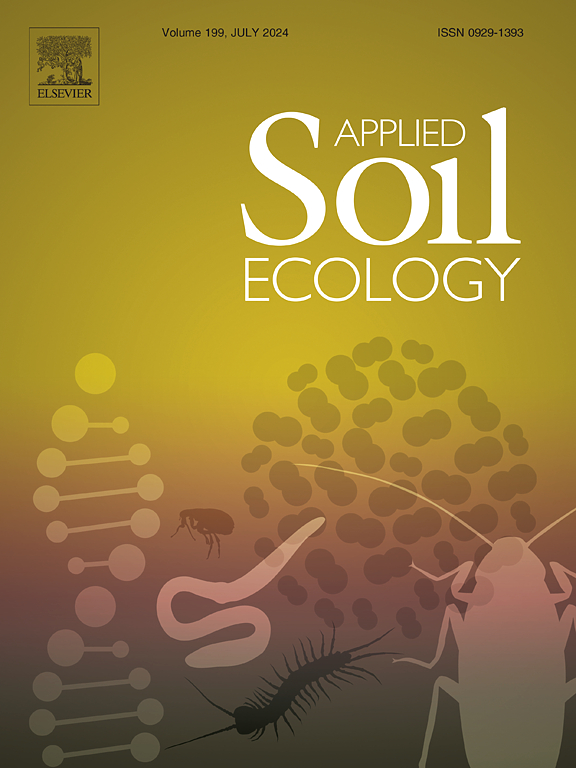Microbial community structure and nitrogen cycling in an area affected by the tailings dam collapse under a rehabilitation process
IF 4.8
2区 农林科学
Q1 SOIL SCIENCE
引用次数: 0
Abstract
The rehabilitation of areas affected by iron ore tailings has significantly altered soil properties and microbial communities (p < 0.05). This study examines the recovery of bacterial communities and nitrogen cycling in two rehabilitated areas impacted by the B1 dam rupture: DA1, a stream channel area with significant engineering intervention, and DA2, near a forest with minimal intervention. Using microbial 16S rRNA gene sequencing we found that Pseudomonadota, Actinobacteriota, Acidobacteriota, Chloroflexota, and Gemmatimonadota represent about 71 % of the total bacteria abundance in rehabilitated areas, we also identified 7 bacterial genera (Terrabacter, Neo b11, Qipengyuania, Curtobacterium, Terriglobus, Parasegetibacter and Rhodopseudomonas) as biomarkers for DA1, 3 (Clostridium, Ensifer and Lacibacter) for DA2, and 8 (Fodinicola, Roseiarcus, Acidipila, Candidatus Udaeobacter, Planotetraspora, Mycobacterium and Clade Ia) for a reference (REF) area. Genera in DA2 and REF were associated with nutrient cycling and plant growth, while DA1 displayed a wider range of metabolisms and degradation capacities. Microbial network analysis revealed more complex networks in rehabilitated areas DA1 (nodes = 3.186; edges = 6.480) DA2 (nodes = 3.224; edges = 6.521) than the reference (nodes = 2.175; edges = 3.020). Nitrogen cycle-related genera were present in both areas, with no significant difference (p > 0.05) in the abundance of nifH, narG and amoA genes, suggesting that technosol supports efficient nitrogen cycling recovery. Overall, the study demonstrates microbial structure and function recovery in impacted areas, with technosol playing a beneficial role, even in regions with complex engineering needs. These findings highlight the potential of technosol for future environmental recovery efforts following dam collapses, motivating us to continue our research and innovation in this field.

尾矿库溃坝修复影响区微生物群落结构与氮循环
铁矿尾矿影响地区的恢复显著改变了土壤性质和微生物群落(p <;0.05)。本研究考察了受B1大坝决堤影响的两个恢复区域的细菌群落和氮循环的恢复情况:DA1是一个有大量工程干预的河道区域,DA2是一个靠近森林但干预最少的区域。通过微生物16S rRNA基因测序,我们发现修复区假单胞菌门、放线菌门、酸杆菌门、绿柔菌门和双胞菌门约占修复区细菌总丰度的71%,我们还鉴定出7个细菌属(Terrabacter、Neo b11、qiipengyuania、Curtobacterium、Terriglobus、Parasegetibacter和Rhodopseudomonas)作为DA1的生物标志物,3个(Clostridium、Ensifer和Lacibacter)作为DA2的生物标志物,8个(Fodinicola、Roseiarcus、Acidipila、Candidatus Udaeobacter)作为DA2的生物标志物,3个(Clostridium、Ensifer和Lacibacter)作为DA2的生物标志物。Planotetraspora, Mycobacterium and Clade Ia)作为参考(REF)区域。DA2和REF中的属与养分循环和植物生长有关,而DA1中的属表现出更广泛的代谢和降解能力。微生物网络分析显示,恢复区DA1(节点= 3.186;DA2 (nodes = 3.224;边缘= 6.521)比参考(节点= 2.175;edges = 3.020)。两区均存在与氮循环相关的属,差异不显著(p >;nifH、narG和amoA基因丰度差异0.05),表明technosol支持有效的氮循环回收。总体而言,该研究证明了受影响地区的微生物结构和功能恢复,即使在具有复杂工程需求的地区,技术溶胶也发挥了有益的作用。这些发现突出了技术溶胶在大坝坍塌后未来环境恢复工作中的潜力,激励我们继续在这一领域进行研究和创新。
本文章由计算机程序翻译,如有差异,请以英文原文为准。
求助全文
约1分钟内获得全文
求助全文
来源期刊

Applied Soil Ecology
农林科学-土壤科学
CiteScore
9.70
自引率
4.20%
发文量
363
审稿时长
5.3 months
期刊介绍:
Applied Soil Ecology addresses the role of soil organisms and their interactions in relation to: sustainability and productivity, nutrient cycling and other soil processes, the maintenance of soil functions, the impact of human activities on soil ecosystems and bio(techno)logical control of soil-inhabiting pests, diseases and weeds.
 求助内容:
求助内容: 应助结果提醒方式:
应助结果提醒方式:


